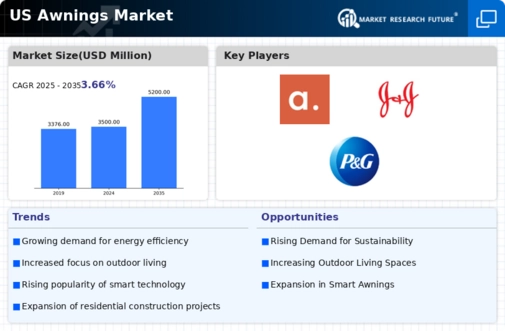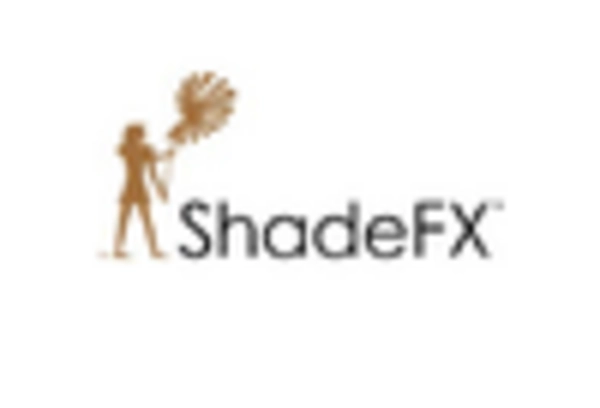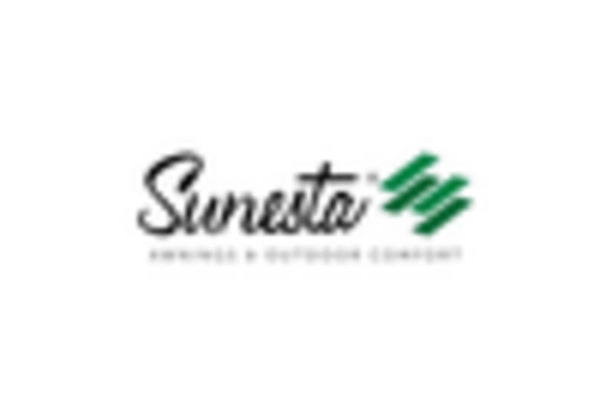Urbanization and Space Constraints
The ongoing trend of urbanization in the US is influencing the awnings market significantly. As more individuals move to urban areas, the demand for space-efficient solutions becomes paramount. Awnings serve as an ideal solution for maximizing limited outdoor spaces, allowing residents to enjoy their balconies, patios, and small yards. This trend is supported by data indicating that urban areas are experiencing a population growth rate of approximately 1.2% annually. Consequently, the awnings market is likely to see increased demand as urban dwellers seek to enhance their outdoor experiences while accommodating their spatial limitations. Manufacturers may respond by offering compact and versatile awning designs tailored to urban living.
Increased Awareness of UV Protection
The heightened awareness of the harmful effects of UV radiation is likely to drive growth in the awnings market. Consumers are becoming more informed about the risks associated with prolonged sun exposure, leading to a greater demand for protective solutions. Awnings provide an effective barrier against UV rays, which can cause skin damage and fade outdoor furnishings. This awareness is reflected in market data, indicating that sales of UV-resistant awnings have increased by approximately 20% over the past year. As health-conscious consumers prioritize safety and comfort, the awnings market is expected to benefit from this trend, with manufacturers focusing on developing innovative materials that offer enhanced UV protection.
Growth in the Home Improvement Sector
The robust growth in the home improvement sector is a key driver for the awnings market. As homeowners invest in renovations and upgrades, the demand for outdoor enhancements, including awnings, is on the rise. Recent data indicates that the home improvement market in the US is projected to reach $500 billion by 2026, with outdoor living products playing a crucial role in this expansion. This trend suggests that consumers are increasingly viewing awnings as essential components of their home improvement projects, contributing to the overall aesthetic and functionality of their properties. Consequently, the awnings market is likely to experience sustained growth as part of this broader home enhancement movement.
Rising Demand for Outdoor Living Spaces
The trend towards enhancing outdoor living spaces appears to be a significant driver for the awnings market. Homeowners increasingly seek to extend their living areas outdoors, creating comfortable and functional spaces for relaxation and entertainment. This shift is reflected in the growing sales of awnings, which are projected to reach approximately $1.5 billion by 2026 in the US. The desire for outdoor aesthetics, combined with the need for protection from the elements, suggests that the awnings market will continue to thrive as consumers invest in their properties. Furthermore, the integration of awnings into landscaping and architectural designs enhances property value, making them an attractive option for homeowners looking to improve their outdoor environments.
Technological Advancements in Materials
Technological advancements in materials are poised to transform the awnings market. Innovations in fabric technology, such as the development of lightweight, durable, and weather-resistant materials, are enhancing the functionality and appeal of awnings. These advancements not only improve the longevity of products but also allow for greater customization options. Market data suggests that the introduction of smart fabrics, which can adjust to environmental conditions, is gaining traction. As consumers increasingly seek high-performance solutions, the awnings market is likely to benefit from these innovations, with manufacturers focusing on integrating advanced materials that offer both aesthetic appeal and practical benefits.

















Leave a Comment